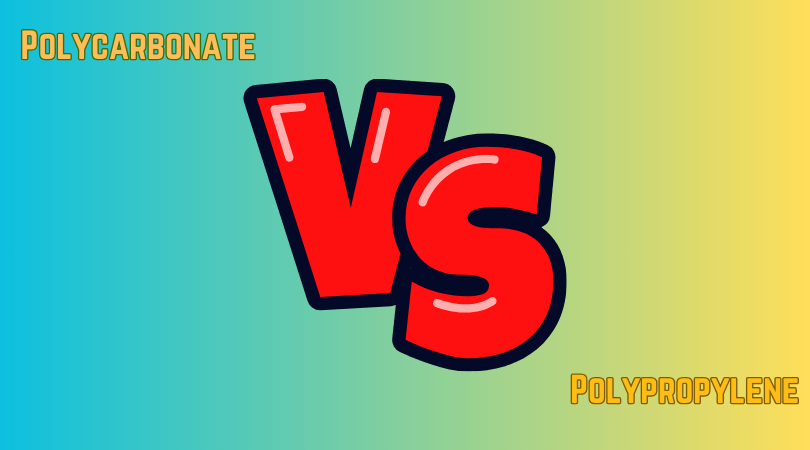In the world of plastics, polypropylene and polycarbonate are two critical materials with widespread applications across various sectors. This detailed analysis aims to delve into the nuanced differences between these two polymers, highlighting their attributes, offering a thorough cost-benefit comparison, and exploring their multifaceted use cases.
Polycarbonate VS Polypropylene
The goal is to provide readers with an insightful understanding of the similarities and disparities between polycarbonate and polypropylene, empowering them to make educated choices during material selection.

What is Polycarbonate
Polycarbonate excels in durability, particularly when subjected to stress and impact, making it a material of choice for various applications.
While it suffers from low scratch resistance, the issue can be mitigated by applying specialized hard coats at an additional cost.
This feature and a high refractive index 1.58 make polycarbonate well-suited for optics like eyewear and lenses.
Various complex coating options, such as polyvinyl alcohol, modified melamine, or silicates, are available, and this is an area of ongoing technical innovation.
Compared to acrylic, polycarbonate has a distinct advantage in higher thermal resistance.
However, PMMA’s lower refractive index of 1.48 means it’s less ideal for optical components.
Polycarbonate is also highly transparent to visible light and frequently replaces glass, especially when impact resistance is essential.
Trade-offs do exist between molecular structure weight and processing ease. Lower molecular weight grades of polycarbonate offer better moldability but at the expense of mechanical strength.
High molecular weight grades are commonly utilized for their robust properties in applications where cost is secondary- such as aerospace. In the automotive industry, polycarbonate is highly valued for its toughness.
Although not inherently stable against UV radiation, this shortfall can be overcome by adding coatings and antioxidants, enhancing its longevity and preventing yellowing.
This has led to its use in vehicle light covers being less prone to yellowing and embrittlement over time.
Polycarbonate is also helpful for roofing due to its durability, transparency, and UV opacity.
As a copolymer, polycarbonate can enhance other polymers’ strength and thermal resistance.
However, its susceptibility to oils, solvents, and organic acids is a significant limitation.
This vulnerability applies to polycarbonate and extends to its copolymer blends, necessitating careful selection for specific applications.
Given your focus on detailed and high-quality information, it is interesting that research is ongoing to develop polycarbonates with enhanced chemical properties and other improved features.
However, such advancements might not be commercially available yet.
What is Polypropylene
Polypropylene, a thermoplastic polymer, is renowned for its versatility and durability, particularly under various environmental conditions, making it a go-to material for multiple applications.
One of its standout features is its resistance to chemical degradation, which gives it an advantage in environments exposed to various substances, from acids to bases.
This intrinsic chemical resistance, combined with a low density of around 0.90 g/cm³, renders polypropylene particularly well-suited for packaging and containers that come into contact with corrosive materials.
When juxtaposed with polyethylene, another ubiquitous thermoplastic, polypropylene offers higher melting and boiling points.
This difference in thermal stability enables polypropylene to be employed in applications that require sterilization at high temperatures.
For example, medical equipment and devices that require autoclaving often utilize polypropylene for this very reason.
Its relatively high melting point of 160°C to 220°C also makes it preferable for hot-fill liquids and foods.
A fascinating aspect of polypropylene lies in its structure, specifically the tacticity or the arrangement of its methyl groups. The tacticity influences its mechanical properties significantly.
Isotactic polypropylene, where the methyl groups are arranged consistently, exhibits superior strength and durability. This isotactic form is widely used in fibers and molded parts, among other applications.
Polypropylene’s lightweight yet sturdy character is highly desirable in the automotive sector.
Its use from dashboard components to door panels has led to significant weight reductions in cars and trucks, improving fuel efficiency.
While UV stability may not be its most vital point, similar to polycarbonate, this limitation can be mitigated by incorporating UV stabilizers, making it more resilient to sunlight exposure.
Another intriguing facet of polypropylene is its role as a copolymer.
Copolymerized with other materials like ethylene can manifest enhanced properties like increased density or improved transparency.
However, care must be taken during the material selection process. For instance, polypropylene is susceptible to oxidation and can be compromised by strong oxidizing agents.
Thus, its application must be carefully evaluated when oxidative environments are involved.
Continuous research is being conducted to improve the properties of polypropylene. One emergent area of innovation involves modifying its crystalline structure to enhance its mechanical attributes further.
While these advances are primarily in the research phase, they hold promise for even broader applications in the future.
Polypropylene VS Polycarbonate: Physical Properties
| Physical Property | Polypropylene (Unfocused, molded or extruded) |
Polycarbonate (Molded or extruded)
|
| Optical Transmission | Variable but can be high in specialized forms |
Exceptionally high, UV opaque
|
| Hardness (Rockwell R) | 20–118 | 114–126 |
| Ultimate Tensile Strength | 9–80 MPa | 28–75 MPa |
| Yield Tensile Strength | 4–1350 MPa | 39–70 MPa |
| Elongation at Break | 2.4–900% | 10–138% |
| Modulus of Elasticity | 0.08–8.25 GPa | 1.79–3.24 GPa |
| Flexural Yield Strength | 0.296–180 MPa | 36–103 MPa |
| Flexural Modulus | 0.026–10 GPa | 0.971–3.1 GPa |
| Coefficient of Friction | 0.25 | 0.31 |
| Coefficient of Thermal Expansion | 18.0–185 µm/m-°C |
50.0–70.2 µm/m-°C
|
| Melting Point | 61–221 °C | 288–316 °C |
| Max Service Temperature | 65–125 °C | 115–135 °C |
These materials have strong points that make them good for certain uses. For example, polycarbonate is clear and blocks UV light, so it’s good for eyeglasses and scientific tools.
On the other hand, polypropylene is stretchy and strong, making it good for things like packaging and clothes.
It can also handle various temperatures and is useful in different environments. Polycarbonate is also tough and doesn’t bend easily, making it good for things that need to be sturdy.
It doesn’t expand or contract much with temperature changes, so it stays the same size and shape. You can’t use these materials for the same things.
When deciding which one to use, you should think about what you need the material to do and pick the one that’s best at those things. This will help you get the best performance and value for your money.
Polypropylene VS Polycarbonate: Applications
Though polypropylene (PP) and polycarbonate (PC) share the stage in the realm of plastics, they rarely overlap in their applications, serving distinct needs based on their intrinsic properties.
Outlined below are the primary industries that leverage the versatility of polypropylene:
Packaging Sector: Used extensively for manufacturing liquid bottles (excluding caps), transparent films, food-grade containers, and heat-shrinkable films.
Automotive Industry: Employed in air management systems for engines and air conditioning, interior components, mud shields, insulating elements, and battery trays for lead-acid batteries.
Healthcare: Integral for crafting syringe barrels, medication receptacles, medical tubing, and facial masks.
Household Goods: Commonly found in domestic items such as water tanks, buckets, septic tanks, electrical appliances, toothbrushes, baby products, and garden equipment.
Chemical Operations: Used in pipelines and valves designed to handle aggressive chemical substances without undergoing stress.
Textile Industry: Implemented as self-colored, durable fibers in textiles, woven tarpaulins, safety garments, carpets, and artificial turf.
Furniture Manufacturing: Utilized resin-based garden, indoor furniture, and decorative, low-stress paneling in more premium furniture pieces.
Shifting the focus to polycarbonate, listed below are its critical applications across various domains:
Medical Devices: Incorporated in specialized equipment like cameras, lenses, and other medical aids.
Protective Optics: Integral in the creation of safety goggles and face shields.
Optical Instruments: Utilized for corrective eyewear and various lens-based instruments, owing to its high refractive index.
Automotive Applications: Commonly used for crafting light covers and lenses in vehicles.
Digital Media: Constitutes the primary material for Blu-ray discs, DVDs, and other forms of optical storage.
Residential and Commercial Interiors: Employed in cupboards, kitchen paneling, and hardware such as handles.
Advertising and Public Spaces: Used in display stands, protective covers for advertisements, weather barriers at bus stops, and other public spaces requiring durability.
Security Measures: Applied in constructing armored, vandal-resistant, and bulletproof windows, serving both vehicular and personnel protection needs.
Agricultural Uses: Commonly seen in greenhouse roofing and windows, providing both durability and UV resistance.
Polycarbonate VS Polypropylene: Cost

When it comes to affordability, polypropylene usually has the edge over polycarbonate. Its lower price point makes it appealing for a wide range of uses. However, several factors contribute to the pricing of each material.
These include the availability of raw materials, production methods, and market demand. The end product’s specific qualities and performance needs can also significantly affect the cost. Therefore, while polypropylene is generally less expensive, the final price can vary depending on many factors.
Concluding Thoughts
In summary, polypropylene and polycarbonate are valuable plastics, each excelling differently. Polypropylene is strong and resists heat and chemicals, making it great for packaging and cars. On the other hand, polycarbonate is best for things that need to be clear and durable, like electronics and safety gear. When picking between the two, looking closely at what you need, including costs, is essential.
Choosing the suitable material involves a detailed look at the job requirements. Each material has pros and cons; understanding these differences is critical to intelligent choice. Factors like cost, performance needs, and specific job demands will influence the final decision. By paying attention to these details, you can pick the material that fits your needs and makes your project the best.
Quick Navigation
